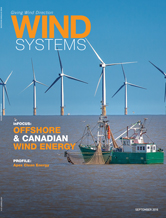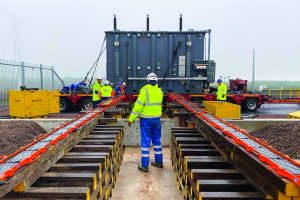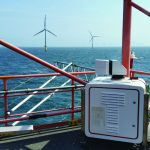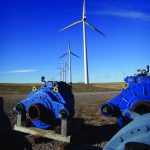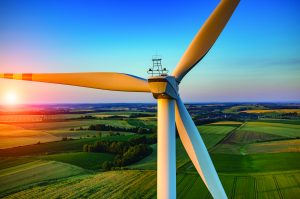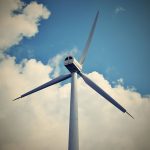For years, Canada’s wind-energy industry has had the potential to expand its market through exports to the United States, but it is only now — bolstered by a perfect storm of supply-and-demand drivers — that the opportunity is finally becoming concrete.
On the U.S. side of the border, state governments and electricity distributors are grappling with the multifaceted challenge of meeting ever-more stringent renewable-energy targets, responding to federal efforts to cut power-plant emissions, and navigating the looming retirement of tens of thousands of megawatts of aging coal and nuclear facilities. Increasingly, they are seeing clean-power exports from Canada as a reliable and cost-effective solution.
The Massachusetts Omnibus Energy Bill is a case in point. The state is looking to Canadian hydroelectricity imports, or hydro, in tandem with onshore wind or other renewable technologies, for as much as 12 TWh of new electricity supply. Its neighboring state, New York, plans to reach 50 percent renewable energy by 2030 and also will need large amounts of clean electricity from Canada.
Meeting the Target
The Obama Administration’s Clean Power Plan (CPP), which aims to slash carbon emissions from the U.S. power sector by 32 percent from 1990 levels over the next 15 years, identifies clean-energy exports from Canada as a viable way for states to meet that target. And many will make that choice.
The North American Electric Reliability Corporation (NERC) predicts that, as the plan comes into effect, Canada-U.S. exports will triple. Whether the CPP survives court challenges and November’s presidential election remains to be seen, but whatever happens, it is clear U.S. commitments under the Paris Agreement will eventually require it to act to clean up its coal-heavy grid.
It’s not surprising that U.S. states are looking north for solutions.

Meeting aggressive targets from in-state wind and solar will be a challenge, especially in the densely populated U.S. Northeast. Siting projects can be difficult; permitting costs are high, and the grid needs additional tools and options to absorb new influxes of variable generation. Coastal states are eyeing offshore wind as a way to meet their clean-energy needs, but that brings a whole other set of issues, ranging from cost to social acceptance.
Canada, meanwhile, produces more than 80 percent of its electricity from emissions-free generating sources, and it already exports about 10 percent of its output to U.S. customers. While the overwhelming majority of that power comes from Canada’s vast complex of hydro reservoirs, there is growing recognition on the Canadian side of the border of the advantages of bringing wind energy into the mix.
A Bundled Product
Major players like Emera and Hydro-Québec are talking about using hydro to back variable sources of generation like wind and delivering a bundled product to their U.S. customers.
In Hydro-Québec’s case, the utility is testing the waters by teaming with Chicago-based Invenergy LLC and developers of the proposed Vermont Green Line transmission project in a bid to supply 400 MW of clean energy to Rhode Island, Connecticut, and Massachusetts. Under the proposal, Québec hydro would supplement the output of Invenergy’s planned Bull Run wind project in northern New York to ensure a firm block of power is delivered 24 hours a day, seven days a week.
The results of the New England Clean Energy request for proposals (RFP) have yet to be announced, but the Québec government already is running with the concept. Its new long-term energy strategy not only looks to boost exports overall, but it also specifically targets the construction of wind farms in Québec as part of the plan.
There are a number of reasons why a wind-hydro bundled product makes sense.
Wind Costs Dropping
First, the cost of wind energy has dropped dramatically, falling 61 percent in the past six years alone. Hydro-Québec’s most recent wind-energy request for proposals ended in the utility paying just 6.3 cents/kWh for the output of three projects totaling 446 MW. When you take 6.3 cents/kWh wind and combine it with low-cost heritage hydro, it becomes interesting for potential buyers, especially when you consider those prices are in Canadian cents.
A wind-hydro hybrid is also better positioned to meet the requirements of prospective customers who want a green product.
Wind is considered a renewable energy source in most of the U.S., and large hydro is often not. Being sensitive to this difference not only expands the market opportunity for Canadian suppliers, but also pays additional dividends. New York and the New England states may allow large hydro to meet a portion of their clean-energy targets, but unlike wind, hydro does not qualify for potentially lucrative renewable energy credits in those markets.
The bottom line is if Canadian utilities don’t incorporate wind into their export product, it represents a lost economic opportunity.

Built for Need
Finally, taking advantage of new markets for clean electricity will require building new generation to meet the demand. On that front, wind energy’s advantages are clear. Wind-generating capacity can be built incrementally in line with need, and it can be deployed quickly. If permits were started on a new large hydro project today, it would not be built for 15-20 years. Most importantly, however, wind energy is less expensive than any new large hydroelectric project now on the drawing board in Canada.
A new study, sponsored by the Canadian Wind Energy Association (CanWEA) and conducted by an expert team led by GE Energy Consulting, underscores the critical role Canadian wind can play in North America’s transition to a clean-energy economy.
The Pan-Canadian Wind Integration Study (PCWIS) examined four cross-Canada development scenarios and found no operational barriers to achieving a 35 percent wind penetration by 2025.
Managing that level of wind on the grid depends heavily on the free flow of electricity across jurisdictions, not just between provinces in Canada, but also across the border with the U.S. It would require 10 GW of new transmission connections between markets, but given that wind would displace more expensive coal- and gas-fired generation in both Canada and the U.S., the operating cost savings would pay for the $3.7 billion capital cost of those lines in just three years.
Increased Exports
The opportunity for Canada to economically benefit from increased exports is significant.
For every 1 MWh of additional wind generation produced in Canada, the analysis found that electricity exports from Canada would increase by 0.5 MWh.
From an environmental aspect, benefits would accrue on both sides of the border. At a 35 percent wind-penetration level, Canada would see 32.3 million metric tons of greenhouse gas reductions, while emissions on the more fossil-dependent U.S. grid would fall by 46.5 million metric tons.
The Pan-Canadian analysis is timely, coming just weeks after leaders of Canada, Mexico, and the U.S. agreed to collectively source 50 percent of North American electricity from clean sources by 2025. Given the U.S. generates 33 percent of its electricity from non-emitting sources of generation and Mexico gets only 18 percent, the target is yet another clear incentive to leverage Canada’s tremendous renewable energy capabilities.
And like the PCWIS, the Three Amigos agreement recognizes the importance of inter-jurisdictional cooperation. The pact includes supporting the development of cross-border transmission projects, and conducting a joint study to better understand the planning and operational impacts of integrating ever-increasing penetrations of variable energy sources.

Four Projects in Works
Working with the U.S. to build new transmission infrastructure is key.
There are already at least four major projects on the drawing board, including two planned links between Québec and New England, one transmission line increasing transfer capacity between Manitoba and Minnesota, and an underwater cable between Ontario and Pennsylvania.
Removing market barriers with coordinated grid planning and operations is also key.
There is an even more fundamental step required, however, if we are going to close the gap between the potential for Canadian wind-energy exports and getting new wind-energy projects in the ground. We need to get the customer on board.
There are some early-mover states, but for many U.S. decision makers, looking outside their home turf for solutions to their challenges is not always a natural step. Educating American legislators and consumers about what Canada has to offer, and how it benefits the U.S., is essential.
Technical Guide
That is one of the reasons CanWEA teamed with a consortium of industry and government partners to produce a technical guide showing U.S. state-level policymakers how to use clean-energy resources from Canada to comply with the CPP targets, as well as other U.S. environmental policy goals. The report, written by the global economic consulting firm The Brattle Group, helps state policymakers and environmental regulators, public utility commissions, and elected state officials understand their options, but it also provides recommendations for ensuring they meet their objectives in the most cost-effective way.
A policy discussion also needs to take place north of the 49th parallel. Shifting the conversation from pipelines to power lines is a good start, but Canada still has work to do to really seize the clean-energy opportunity.
The Brattle Report shows what U.S. states can do to access carbon-free electricity from Canada, but we need to develop and implement a renewable-energy export strategy to make sure we have the products they want and the ability to deliver them.
Canada may have the cleanest power system in the G7, but the PCWIS demonstrates that it is possible to go much further. That is important because the only way to get the large-scale emissions reductions required to address climate change is to aim for a 100 percent zero-emissions grid and to use that clean electricity to power Canada’s vehicles, buildings, and industry, and help our U.S. neighbors do the same.
















